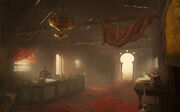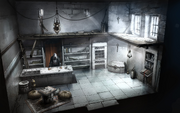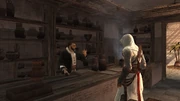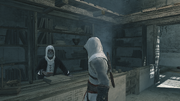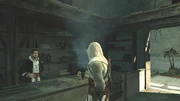
Altaïr in an Assassin bureau in Damascus
An Assassin bureau was a command center used by the Assassin Order, most often located within cities where they also served as safe houses. Their primary function was to act as bases of operation through which missions could be processed and overseen. Bureaus typically doubled as shops as well. More than mere fronts for the Assassins, these stores would trade in genuine merchandise such as silks,[1] carpets,[2] and pottery,[3] or offer services like tailoring,[4] generating income for the Brotherhood.
A tradition that dated back to at least the 1st century BCE, bureaus were an integral component of the Assassins' operational structure.[5] Throughout the ages, not all Assassin Guilds utilized the bureau as an administrative unit, at times relying on other organizational methods such as dens,[6] but the system remained in use into the 20th century.[4] It was indefinitely rendered obsolete after the Great Purge of 2000 which decimated the Assassins and forced them to rely almost exclusively on mobile cells.[4][5][7]
History[]
Ptolemaic Egypt[]
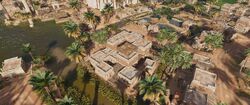
The Hidden Ones bureau in Memphis
The first known bureau was founded in Memphis,[8] Egypt sometime between 47 and 44 BCE, not long after the creation of the Hidden Ones by Bayek and Aya.[9] By 43 BCE, Aya had established a bureau in the Pantheon district of Rome.[8]
By 38 BCE, a third bureau was established in the Sinai by one of Bayek's first Hidden One recruits, Tahira.[10] The Sinai bureau had a secret exit that backed onto mountains.[11] Unfortunately, the Sinai bureau was destroyed by fire,[12] and the Hidden Ones of Sinai fled to the mountains of the Arsinoe Nome,[13] where they made a new bureau.[11]
At some point before 30 BCE, a bureau was established in Alexandria. This bureau would be immortalized as the location for the final synod of the Hidden Ones presided by Amunet as documented in The Magas Codex.[14]
Roman Empire[]
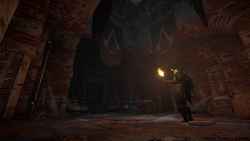
The abandoned Hidden Ones bureau in Camulodunum, Essexe during the 9th century
The Roman Hidden Ones that operated in the province of Britannia between the years 100 and 430 CE had six main bureaus. These were located in Ledecestrescire, Lunden, Wincestre, Jorvik, Essexe, and Glowecestrescire.[15] Another branch of Hidden Ones operated in Roman Gaul around the same time and had established four bureaus, one in each region of Amienois, Melunois, and Evresin which were all centered around their main base in Paris itself.[16]
Shortly after the death of the Western Roman Emperor Honorius in 423 CE, magister Vitus wrote to the Hidden Ones stationed at Leicester, warning them that Britain would be imminently unstable due to the local tribes who harbored ill sentiments towards them having filled the power vacuum left by the departing Roman legions. Reasoning that it would be better to restart the branch later rather than suffer the loss of its members to unnecessary bloodshed, he ordered that the letter's recipient immediately evacuate and move their headquarters to the German city of Cologne and join forces with the local chapter.[17]
Within the year, word of the evacuation reached the Hidden Ones in Gaul who had experienced similar misunderstandings themselves with the local Gallic tribes. Seeing the situation was untenable, the magister known only as "C. C." wrote to the surrounding bureaus from Paris and ordered all Hidden Ones to hide the three keys necessary to unlock the Paris location, seal the rooms, and likewise abandon Gaul until such time had passed that they could safely return and resume their fight against tyrants and the Order of the Ancients for humanity's freedom. Before closing their letter, C. C. also informed the Hidden Ones that Vitus had extended an invitation from Cologne, adding that they too would join any who were willing to travel to Germania. While the majority of C. C.'s orders were carried out, a few Hidden Ones refused to abandon their posts and decided to stay in Gaul to continue their work on a more individual scale.[18]
Middle Ages[]
9th century[]
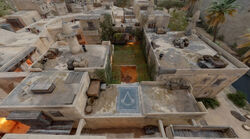
The Hidden Ones bureau in Harbiyah, Baghdad
In the early 860s, the Hidden Ones of Alamut expanded their outreach from their fortress into Baghdad,[19] where they established a number of bureaus throughout the city to combat the Order of the Ancients' influence.[20] Initially maintaining only one bureau in the Harbiyah district, the Hidden Ones soon expanded to also have bureaus in the Abbasiyah and Karkh districts, as well as the Sharqiyah sub-district of Karkh.[21]
Each Baghdad bureau was led by a Rafiq, who granted Hidden Ones permission to carry out assassinations by giving them a feather to dip in the target's blood, and featured a notice board where various contracts were posted. The bureaus also included a workshop for one of the Banū Mūsā brothers – Abu Jafar, Ahmad and Al-Hasan – to work on their inventions and gadgets, which were given to the Hidden Ones to aid them during their missions.[21]
By 870, some Frankish Hidden Ones had relocated to a new bureau in Chinon. That year, the young Hidden One Oisel received a letter from Basim Ibn Ishaq of the local branch of Hidden Ones in Constantinople, which asked him to follow Basim's travels in the Levant, starting in Antioch.[22]

The Ravensthorpe bureau
In 873, Basim and Hytham established a bureau in the Norse settlement of Ravensthorpe in England with the help of their ally, the shieldmaiden Eivor Varinsdottir of the Raven Clan.[23] Because of Hytham's severe wounding in his attempt to assassinate Kjotve the Cruel,[24] Basim assigned him to oversee and upkeep the bureau. Inside the office, Hytham kept numerous scrolls detailing missions and members of the Order of the Ancients. To combat the Order's reign in England, Hytham often received letters from a "Poor Fellow-Soldier of Christ", who relayed information on key assassination targets in the cities of Lunden, Jorvik, and Wincestre.[25]
During the 870s, Eivor, at Hytham's request, explored the abandoned Hidden Ones bureaus in England and recovered pages of the Magas Codex, contracts for assassinations, and letters between the members of the bureaus.[17] After sailing to Francia in 885 to assist the second Viking siege of Paris, Eivor took time to visit all the ruined Gallic Hidden Ones bureaus and recovered the keys to the Paris office, where she found and claimed Charlemagne's short sword Joyeuse from a treasure chest that had been secreted away. As she left the premises, she indirectly met the Frankish Hidden One Abbo of Cernuus under the alias "AC" by way of a letter he left on the ground after she had entered the building.[18]
Crusades[]
Bureaus were widely used by the Levantine Brotherhood of Assassins, with some cities such as Acre, Damascus, Jerusalem,[26] and Tyre[27] having one per district. Bureaus acted as sanctuaries for members of the Assassin Order, where their users could physically and mentally prepare themselves for a mission, allowing them to restock on throwing knives, sleep, or to meditate. It also allowed Assassins a place to wait for the appropriate moment to strike or for the dust to settle after an assassination.[26]
Inside each bureau resided a leader, who held either the rank of Rafiq or higher. They would often give Assassins useful information on where to learn more about their targets. Once the strike had been planned and approved by the bureau leader, an Assassin was given a feather to soak in the blood of their target as proof of their success.[26]These bureaus all had a similar construction. The exterior of the building was typically quite discreet, resembling that of common construction, although they did not have any obvious windows or doors. The entrance was usually located on the roof.[26]
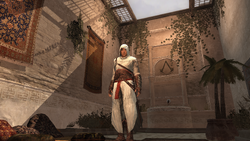
A Third Crusade bureau's main chamber
A main chamber served as the entrance hall to the bureau, and was a small living area comprised of two fountains, potted plants, and several pillows and carpets. This place was intended as a location for Assassins to rest before and after assassinations. The walls were decorated with hanging carpets and the Assassin insignia, while the ceiling was grated with an opening that acted as an entrance into the Bureau.[26]
Some bureaus took the living area comforts a bit further, as the Acre bureau's walls were lined with books while the Damascus bureau contained a chess set and a board on which to play. When the city guards were on alert, the bureau's roof was closed with a grated panel to prevent them from discovering the place and subsequently violating a tenet of the Creed.[26]

The Bureau leader's chamber
A bureau leader's chamber was adjacent to the main chamber. From behind a desk, each leader addressed those who would come to speak with them, while also studying and attending to the Assassin Order's operations in that respective city. Behind the desk were bookshelves and closets, where registries of missions were kept. The books and scrolls the leader had access to were also located in this area. Across the room, a raised walkway held weapons, books, and other items that could assist Assassins in their missions.[26]
Renaissance[]
Before Hülegü Khan ordered the destruction of Masyaf[28] in retaliation for their part in assassinating his father Genghis Khan,[29] the Levantine Assassins' Mentor Altaïr Ibn-La'Ahad sent brothers Maffeo and Niccolò Polo to establish new guilds and bureaus around the Mediterranean Sea such as Italy and Constantinople where Assassin presence had waned.[28]
In 1512, a team of Assassins established a new bureau in Venice after taking control of an old Templar stronghold.[30]
Golden Age of Piracy[]
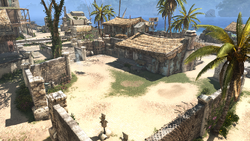
The Assassin bureau in Havana
During the early 18th century, the West Indies Brotherhood had bureaus spread throughout the major cities in the Caribbean, which varied in size and appearance. The bureaus in Havana and Kingston held at least one building and had a surrounding courtyard or walls; the Nassau bureau consisted of a small collection of buildings; and the Cayman Islands' "ghost" bureau had no defined buildings or areas to speak of.[31]
After killing the Assassin turncoat Duncan Walpole in 1715,[32] Edward Kenway recovered and subsequently sold a map detailing the four bureaus' locations to the local branch of Templars operating in the region,[33] unwittingly putting the Assassins stationed there in danger. Edward eventually traveled to the four bureaus and made amends for disclosing their locations;[34] in doing so, he assisted the bureau Masters in various ways, in return for a collection of keys that would grant him access to a set of Templar Armor.[35]
Seven Years' War[]
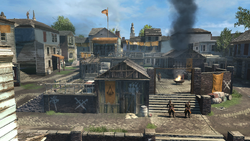
A gang headquarters in New York
The Colonial Assassins during the mid-18th century primarily operated out of the Davenport Homestead, but they also maintained a number of bureaus throughout the British and French Colonies, namely in New York, Albany, Lac Eternel, Two Bends and Halifax. Because the Colonial Brotherhood worked closely with the local criminal gangs, who supplied them with information and manpower, these bureaus doubled as gang headquarters.[36]
During the Seven Years' War, the Assassin-turned-Templar Shay Cormac cleared all of the Brotherhood's gang headquarters with the assistance of the British Army, to put a stop to the gangs' activities and cripple the Assassins' information network.[36]
Victorian era[]

Henry and the Frye twins inside the curiosity shop
In the mid-19th century, the British Brotherhood had a bureau in the Whitechapel district of London, which was headed by the only Assassin left in the city, Henry Green. Because of the Templars' strong presence in London at the time, the bureau was disguised as a curiosity shop to avoid detection by the Blighters, a gang allied with the Templars. From the bureau, Henry maintained contact with his allies in the city,[37] as well as the British Assassin Council, whom he petitioned for help against the Templar threat.[38]
Following the arrival of the twin Assassins Jacob and Evie Frye in London in 1868, they helped Henry eliminate the Templar presence in Whitechapel and claimed Rexford Kaylock's train hideout, which became the Assassins' new base of operations.[39]
Russian Revolution[]
By 1918, the Russian Brotherhood had a bureau in Moscow. That year, the Assassin Nikolai Orelov was sent to the bureau after his retrieval of a Precursor box and his rescue of Anastasia Romanova, in order to report back to the Mentor. While waiting in the bureau, Nikolai overheard a conversation between two Assassins and learned about the Brotherhood's plans with Anastasia, prompting him to escape the building in order to rescue the girl from the experiments she was about to be subjected to.[40]
List of known bureaus[]
- Abbasid Caliphate
- Abbasiyah bureau (Baghdad)[21]
- Harbiyah bureau (Baghdad)[21]
- Karkh bureau (Baghdad)[21]
- Sharqiyah bureau (Baghdad)[21]
- Britain
- Camulodunum bureau[17]
- Eboracum bureau[17]
- Londinium bureau[17]
- Ratae bureau[17]
- Ravensthorpe bureau[23]
- Temple of Ceres bureau[17]
- Venta Belgarum bureau[17]
- Whitechapel bureau (London)[37]
- Byzantine Empire
- Constantinople bureau[22]
- China
- Colonial America
- Egypt
- France
- Germany
- Italy
- Levant
- Russia
- West Indies
Gallery[]
Appearances[]
- Assassin's Creed (first appearance)
- Assassin's Creed: The Secret Crusade
- Assassin's Creed IV: Black Flag
- Assassin's Creed: Identity (mentioned in Database entry only)
- Assassin's Creed: Rogue
- Assassin's Creed: Syndicate
- Assassin's Creed: Underworld
- Assassin's Creed Chronicles: Russia
- Assassin's Creed: Origins
- Assassin's Creed: Brotherhood of Venice
- Assassin's Creed: Valhalla
- Assassin's Creed: The Silk Road (mentioned only)
- Assassin's Creed: Mirage
References[]
| ||||||||||||||||||||||||||||











